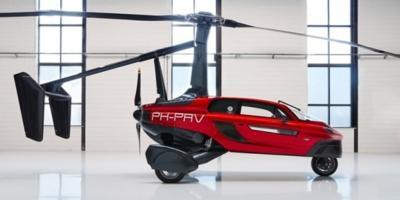It’s a Bird, It’s a Plane, It’s a …
PAL-V is a Dutch aerospace concern about the business of developing a commercial flying car. The PAL-V moniker is an acronym denoting Personal Air and Land Vehicle.

Dubbed Liberty, the machine PAL-V aspires to bring to market is a compact, two-seat affair contemporaneously suited to powered flight and travel on public roads.
In broad-strokes, Liberty’s resembles the illegitimate offspring of an autogyro and a Reliant Robin—a small, three-wheeled automobile produced by England’s Reliant Motor Company. The autogyro analogy is substantiated by PAL-V’s website, which sets forth:
“As eighty-percent of the future PAL-V carflyers are new to aviation, some of them have started the training for a gyroplane flying license at the PAL-V FlyDrive Academy.”
In its roadgoing configuration, Liberty’s two-blade main-rotor, aft-mounted pusher-propeller, and single-boom H-tail empennage fold to a remarkably compact overall size. The main-rotor’s two blades hinge at approximately half their respective spans, and the pusher-propeller’s two-blades hinge at the hub. Liberty’s undercarriage telescopes dramatically—extending for flight operations and retracting for road use.

Liberty is powered by two discrete engines, a one-hundred-horsepower road mill and a two-hundred-horsepower flight powerplant, about which little else is currently known—excepting they burn Euro 95, 98, and E10 fuels.
PAL-V chief technical officer Mike Stekelenburg stated: “For me, the trick in successfully making a flying car is to ensure that the design complies with both air and road regulations. I feel the energy and motivation in our team to push hard for the last few milestones and get the Liberty certified for flying too.”
PAL-V test-driver Hans Joore remarked: “When I fired-up the PAL-V for the first time I really got goosebumps! All the effort that we put into it came together at that crucial moment. Hearing the vehicle come to life was just magnificent and driving it was great. It is very smooth and responsive to the steering and with a weight of just 660 kg it accelerates really well. The overall experience is like a sports-car. It feels sensational.”

PAL-V’s Liberty has been undergoing assessment by the European Aviation Safety Agency (EASA) since 2015. Certification of the design is expected to be granted before the end of 2023.
Viewing PAL-V’s Liberty through the lens of specifications requires, in point of fact, two lenses—one each for the machine's road and air-going incarnations.
Terrestrially, Liberty is a four-meter-long, two-meter-wide, 1.7-meter-tall contraption with a maximum speed of 86-knots and a range of 710-nautical miles. At the dragstrip, the Liberty accelerates from zero to one-hundred-kilometers-per-hour in just under nine-seconds.
In flight, Liberty is a 6.1-meter-long, two-meter-wide, 3.2-meter-tall powered gyroplane with 10.75-meter rotor-diameter, an economy cruise-speed of 140-knots, a high cruise-speed (90-percent power) of 86-knots, a maximum speed of 97-knots, and a two-occupant range of 215-nautical-miles (with a thirty-minute fuel reserve). The removal of one occupant boosts Liberty’s range to 269-nautical-miles. More importantly, Liberty’s minimum level-flight speed is 26.9-knots. PAL-V lists Liberty’s service-ceiling as 11,482-feet.

Empty, Liberty masses 1,464-pounds. Maximum takeoff weight is 2,006-pounds. Ergo, by simple mathematics, Liberty’s useful load is 542-pounds.
To the subjects of his company’s product and the means by which it’s to be marketed, PAL-V CEO Robert Dingemanse set forth: “It’s another great step forward for us, now we ‘drive’ ahead to the last milestones. In parallel we organize roadshows across Europe to demonstrate the PAL-V to customers: Where shall we meet?”
 ANN FAQ: Contributing To Aero-TV
ANN FAQ: Contributing To Aero-TV ANN's Daily Aero-Linx (05.29.24)
ANN's Daily Aero-Linx (05.29.24) ANN's Daily Aero-Term (05.29.24): NORDO (No Radio)
ANN's Daily Aero-Term (05.29.24): NORDO (No Radio) ANN's Daily Aero-Term (05.30.24): Beyond Visual Line Of Sight (BVLOS)
ANN's Daily Aero-Term (05.30.24): Beyond Visual Line Of Sight (BVLOS) ANN's Daily Aero-Linx (05.30.24)
ANN's Daily Aero-Linx (05.30.24)






